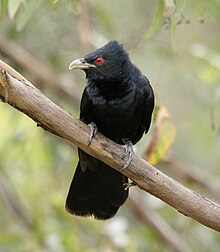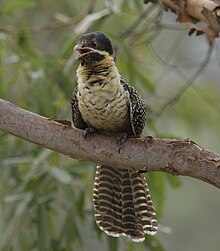Loading AI tools
Species of bird From Wikipedia, the free encyclopedia
The Pacific koel (Eudynamys orientalis), also known as the eastern koel or formerly common koel, is a species of cuckoo in the family Cuculidae. In Australia, it is colloquially known as the rainbird or stormbird, as its call is usually more prevalent before or during stormy weather.
| Pacific koel | |
|---|---|
 | |
| Male | |
 | |
| Female | |
| Scientific classification | |
| Domain: | Eukaryota |
| Kingdom: | Animalia |
| Phylum: | Chordata |
| Class: | Aves |
| Order: | Cuculiformes |
| Family: | Cuculidae |
| Genus: | Eudynamys |
| Species: | E. orientalis |
| Binomial name | |
| Eudynamys orientalis (Linnaeus, 1766) | |
 | |
| Distribution of the Pacific koel in turquoise (also outside the map in southeast Australia) | |
| Synonyms | |
|
Cuculus orientalis Linnaeus, 1766 | |
The Pacific koel was formally described by the Swedish naturalist Carl Linnaeus in 1766 in the twelfth edition of his Systema Naturae. He placed it with the cuckoos in the genus Cuculus and coined the binomial name Cuculus orientalis.[2] Linnaeus based his account on the "Le Coucou noir des Indes" that had been described and illustrated in 1760 by the French zoologist Mathurin Jacques Brisson in his multi-volume work Ornithologie.[3] The type locality is Ambon Island, one of the Maluku Islands of Indonesia.[4] The Pacific koel is now placed in the genus Eudynamys that was introduced in 1827 by the naturalists Nicholas Vigors and Thomas Horsfield.[5] It was formerly considered to be conspecific with the Asian koel (Eudynamys scolopaceus) and the black-billed koel (Eudynamys melanorhynchus).[4][6][7]
Eight subspecies are recognised:[5]
The Pacific Koel can be identified by its black plumage, often tinted with blue and green, and red eyes. The species is sexually dimorphic: the female has brown plumage along the back with white spots and the underbelly is often cream coloured with fine black stripes. Young birds resemble the female but have dark eyes.
It is found in forest, woodland, plantations and gardens from Wallacea east to the Solomon Islands and south to northern and eastern Australia. The Pacific koel has not been rated by IUCN, but the Australian Koel (here included in the Pacific koel) is considered to be of Least Concern.[1]
The Pacific koel is a brood parasite. In Australia, their hosts are mainly large honeyeaters (especially noisy friarbirds and red wattlebirds).[8] Unlike in other parasitic cuckoos, the young do not attempt to kill the host chicks. This trait is shared with the channel-billed cuckoo, which – as in the Pacific koel – are largely frugivorous as adults.[9] A study of vocalization noted that the duetting behaviour may indicate the possibility of short-term pair-bonding in its otherwise polygynous mating system.[10]
In Australia, the presence of the species is regarded as a sign of the arrival of spring and the rainy season. It is also viewed as a nuisance due to the males' incessant calling throughout the day and night.[11][12] The calls indicate the start of breeding season and males would call repeatedly to mark their territory or communicate their availability to other females.[13]
Seamless Wikipedia browsing. On steroids.
Every time you click a link to Wikipedia, Wiktionary or Wikiquote in your browser's search results, it will show the modern Wikiwand interface.
Wikiwand extension is a five stars, simple, with minimum permission required to keep your browsing private, safe and transparent.